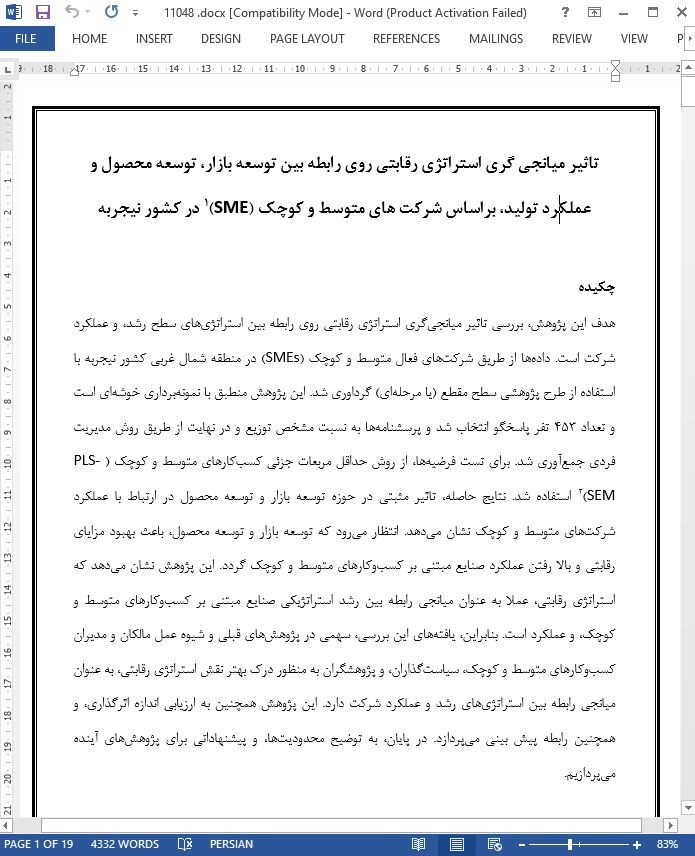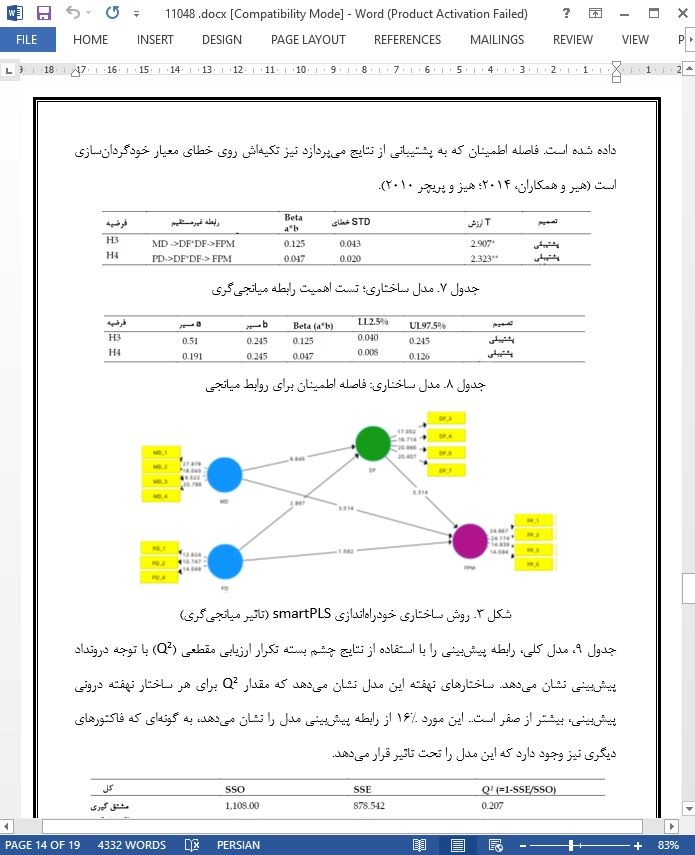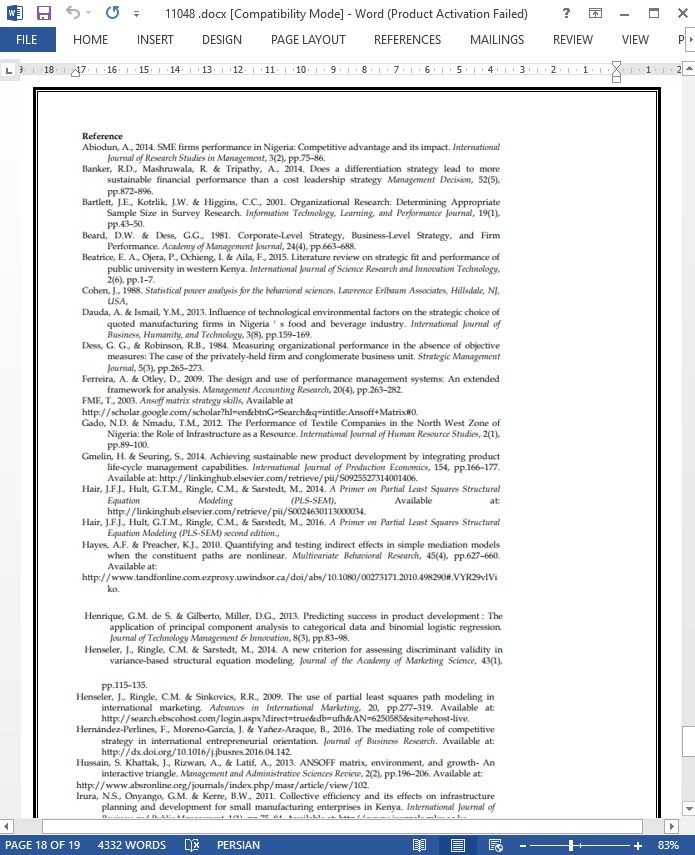
تاثیر میانجی گری استراتژی رقابتی روی رابطه بین توسعه بازار، توسعه محصول و عملکرد تولید
چکیده
هدف این پژوهش، بررسی تاثیر میانجیگری استراتژی رقابتی روی رابطه بین استراتژیهای سطح رشد، و عملکرد شرکت است. دادهها از طریق شرکتهای فعال متوسط و کوچک (SMEs) در منطقه شمال غربی کشور نیجربه با استفاده از طرح پژوهشی سطح مقطع (یا مرحلهای) گرداوری شد. این پژوهش منطبق با نمونهبرداری خوشهای است و تعداد 453 تفر پاسخگو انتخاب شد و پرسشنامهها به نسبت مشخص توزیع و در نهایت از طریق روش مدیریت فردی جمعآوری شد. برای تست فرضیهها، از روش حداقل مربعات جزئی کسبکارهای متوسط و کوچک ( PLS-SEM) استفاده شد. نتایج حاصله، تاثیر مثبتی در حوزه توسعه بازار و توسعه محصول در ارتباط با عملکرد شرکتهای متوسط و کوچک نشان میدهد. انتظار میرود که توسعه بازار و توسعه محصول، باعث بهبود مزایای رقابتی و بالا رفتن عملکرد صنایع مبتنی بر کسبوکارهای متوسط و کوچک گردد. این پژوهش نشان میدهد که استراتژی رقابتی، عملا به عنوان میانجی رابطه بین رشد استراتژیکی صنایع مبتنی بر کسبوکارهای متوسط و کوچک، و عملکرد است. بنابراین، یافتههای این بررسی، سهمی در پژوهشهای قبلی و شیوه عمل مالکان و مدیران کسبوکارهای متوسط و کوچک، سیاستگذاران، و پژوهشگران به منظور درک بهتر نقش استراتژی رقابتی، به عنوان میانجی رابطه بین استراتژیهای رشد و عملکرد شرکت دارد. این پژوهش همچنین به ارزیابی اندازه اثرگذاری، و همچنین رابطه پیش بینی میپردازد. در پایان، به توضیح محدودیتها، و پیشنهاداتی برای پژوهشهای آینده میپردازیم.
1 مقدمه
تمرکز فعایتهای کسبوکار امروزی، هم برای کشورهای توسعه یافته و هم کشورهای در حال توسعه روی این موضوع است که چگونه کسبوکارهای متوسط و کوچک (SMEs) را در مسیر رشد و ثبات قرار دهیم. از این رو، کسبوکارهای متوسط و کوچک (SMEs)، مورد توجه بسیاری از نهادها، برای مثال سازمانهای غیردولتی(NGO) ، نهادهای پژوهشی، بخش مشاغل و غیره است. علاوه بر این، کسبوکارهای متوسط و کوچک (SMEs) به عنوان موتور رشد و توسعه اقتصادی، در کشورهای در حال توسعه و کشورهای توسعه یافته به دلیل مزایای بیشمار حاصل از این کسبوکارها، به حساب میآیند (کونگولو 2010) . کسبوکارهای متوسط و کوچک (SMEs)، نقش مهمی در اشتغالزایی، نوآوریهای جدید، افزایش تولید، رشد فناوری، بکارگیری منابع، رشد ناخالص داخلی (GDP) ، و فراتر از همه کاهش فقر، دارند (ابیودان 2014؛ واشینگتن 2014) .
7.2 محدودیتها و دستورالعملهایی برای پژوهشهای آینده
یافتههای این پژوهش دارای تعدادی محدودیت است. ابتدا اینکه این پژوهش محدود به دو استراتژی رشد انساف و تنها یک توپولژی عمومی پورتر است، بنابراین، پژوهشهای دیگر از این دست به منظور بررسی رابطه بین استراتژی رشد، استراتژی رقابت و عملکرد مد نظر قرار میگیرد که شامل نمونههایی از صنایع کوچک و بزرگ شرکت محور است. این موارد درک محققان را افزایش داده و به پشتیبانی تعمیمپذیری این یافتهها میپردازد. همچنین اندازهگیری متغیرهای مورد استفاده در این پژوهش محدود به سنجشهای سازگار با کشورهای غربی است. پژوهشهای آینده شاخصهایی را مد نظر قرار میدهد که میتواند برای این شرایط مناسبتر باشد. دوم اینکه، این پژوهش ماهیتا مقطعی است، و محدود به صنعت مبتنی بر کسبوکارهای متوسط و کوچک (SMEs) واقع در شمال غربی نیجریه است. بنابراین، تعمیم این پژوهش به بخشها و مناطق دیگر برای پژوهشهای آینده پیشنهاد میگردد. این پژوهش براساس منبع داده جداگانه صورت گرفته است، برای تعمیم یافتهها، احتیاط باید صورت گیرد. در نهایت، این پژوهش، به بررسی تاثیر میانجیگری استراتژی تفکیک روی رابطه بین توسعه بازار، توسعه محصول، و عملکرد کسبوکارهای متوسط و کوچک (SMEs) فعال در شمال غربی نیجریه میپردازد. تعمیم این پژوهش به مناطق دیگر و مطالعات تطبیقی منجر به بهبود درک ما از تطبیق راهبردی بین جهتگیریهای راهبردی شرکت و مزایای رقابتی میگردد.
Abstract
The aim of this study is to examine the mediating effect of competitive strategy on the relationship between growth level strategies, and firm performance. Data was compiled from the manufacturing based SMEs operating in the North-West region of Nigeria, using cross-sectional research design. This study adopted cluster sampling and randomly selected 453 respondents and questionnaires were proportionately distributed and collected through personally administered method. PLS-SEM was used to test the hypotheses. The results found positive impact to both market development and product development on the SME performance. It is expected that market development and product development will improve the competitive advantage and enhance performance of manufacturing based SMEs. The study found that competitive strategy empirically mediates the relationship between the strategic growth of manufacturing based SMEs and performance. Therefore, the findings of this study contribute to the literature and practice of SMEs owners-managers, policy makers, and researcher with better understanding on the role of competitive strategy in mediating the relationship between growth strategies and firm performance. The study also assessed the effect size, as well as the predictive relevance. Finally, limitations and suggested for further studies were represented.
1 Introduction
The focus of today's business operations, for both developed and developing countries, is how to improve Small and medium enterprises (SMEs), towards growth and sustainability. Hence, Small and medium enterprises (SMEs) are gaining more concerned from institutions, for example; NonGovernmental Organization (NGO), research institutions, practitioners and so along. Moreover, SMEs has been realized as the engine of economic growth and development, not only to the developing economies, equally the developed countries to benefits enormously from the SMEs (Kongolo 2010). SMEs contributes greatly to job creation, youth innovation, increases production, technology growth, resource utilization, GDP and above all the poverty reduction (Abiodun 2014; Washington 2014).
7.2 Limitations and Direction for Future Studies
This finding of this study has some limitations. First the study was limited to two growth strategies of Ansoff, and only one Porter’s generic typologies, hence, an extension of this work would be interesting to examine the the relationship between growth strategy, competitive stratey and performance that include sample of both small and large manufacturing based firms. That would enhance the researchers understanding and support further generalizability of the findings. Also, the measeurements of variables used in this study was limited to adapted measures from the Western countries, future studies may develop indicators that may more appropriate in this context. Secondly, the study is crosssectional in nature, and limited to manufacturing based SMEs that operates in Northwest of Nigeria. Therefore, an extension of this survey to other sectors and regions is suggested for future research. The study was conducted based on a single data source, caution must be considered when generalizing the findings. Finally, the survey investigates the mediating effect of differentiation strategy on the relationship between market development, product development, and firm performance of SMEs operating in the Northwest of Nigeria. An extension to other regions and comparative study would further improve our understanding on strategic match between firm’s strategic orientations and competitive strategy.
چکیده
1. مقدمه
2.0 مرور پژوهشهای پیشین
2.1 عملکرد شرکت
3.0 چارچوب پژوهش
4.0 روش بررسی
4.1 گرداوری داده و نمونه
5.0 تحلیل داده
5.1 آمار پاسخدهندگان
5.2 تحلیل و تحلیلهای مدل اندازهگیری
5.3 تست فرضیهها و نتایج
6.0 نتیجهگیری
7.1 مشارکت
7.2 محدودیتها و دستورالعملهایی برای پژوهشهای آینده
Abstract
1 Introduction
2.0 Literature Review
2.1 Firm performance
3.0 Research Framework
4.0 Methodology
4.1 Sample and data collection
5.0 Data Analysis
5.1 Demography of Respondents
5.2 Measurement Model Analyses
6.0 Conclusion
7.1 Contributions
7.2 Limitations and Direction for Future Studies
- اصل مقاله انگلیسی با فرمت ورد (word) با قابلیت ویرایش
- ترجمه فارسی مقاله با فرمت ورد (word) با قابلیت ویرایش، بدون آرم سایت ای ترجمه
- ترجمه فارسی مقاله با فرمت pdf، بدون آرم سایت ای ترجمه



